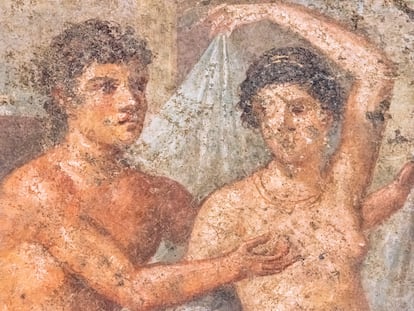Twenty years of good-looking priests in Rome
A calendar containing images of handsome preachers has become an editorial success. For the two decades that the Italian publication has been on the market, it hasn’t changed its essence

Believe it or not, for the past 20 years, in every corner of Rome — both a sacred and profane city par excellence — there’s been a handsome priest, who smiles and makes eye contact with visitors.
In the Eternal City, cassocks and collars are everywhere. They’re simply part of the city’s landscape, like the domes, fountains or cobblestones. Some are real, given that there are thousands of priests and religious people who populate the city. Others are snapshots that hang in the windows of kiosks and souvenir shops. The latter — young men who are included in a particular calendar — attract a lot of attention.
Thousands of visitors leave the Italian capital with miniature statuettes of some iconic monument, packages of pasta and copies of the famous calendar. The official name of this almanac — which turns 20 next year and can now be purchased in advance — is the Roman Calendar. However, everyone knows it as the “handsome priests” calendar, for obvious reasons. It has gone from being a tourist guide with information about the Vatican to a cult souvenir.
In this almanac, each month displays an image of a handsome, anonymous priest, who’s photographed in black-and-white. Some wear ecclesiastical hats — most wear collars. They all stand out for their beauty. Images of the Catholic clergy are among some of the most evocative symbols of Rome.
“A young and beautiful face is the best option to make the product more attractive. The intention is to capture the interest of a broad sector of the public,” explains Piero Pazzi, during an interview with EL PAÍS. The 64-year-old Venetian is an archivist, a photography enthusiast and the creator of the calendar.
The Vatican has made it clear that the calendar isn’t official and that it’s “an individual initiative.” While the almanac doesn’t have the blessing of the Holy See, dozens of copies are sold around Saint Peter’s Square, or next to the tailor shop that dresses the cardinals, without major problems.
The yearbook will celebrate its 20th edition next year, with the same essence that it has always maintained. It contains practically the same collection of images that, two decades ago, made it a star souvenir.
During its peak — in the mid-2010s — nearly 75,000 copies were sold annually. Although sales dropped during the pandemic, demand remains high. If something works, why change it? That’s Pazzi’s philosophy. “The project has worked well, sales remain stable,” he points out. “The photos are almost always the same, [although] the messages change,” he clarifies.
He notes that it emerged as an instrument to “instruct and help tourists who visit Rome, providing them with precise information about the Vatican,” with fun facts written inside. The calendar offers “very simple information, which the average tourist has no idea about.”
“Every year,” Pazzi sighs, “the quality of tourism worsens. Many tourists don’t even know where they are. Through the calendar, I aim to help them understand where they’re spending their vacation and what’s around them.” Among other things, within its pages, the calendar describes the organization of the Vatican, gives details about the pharmacy within the tiny state that dispenses medicines from all over the world and lists the opening hours of the various museums and the Sistine Chapel. It also offers — in loose notes — small glimpses of history between its pages.
On the surface, the images of the good-looking priests may not have a very clear relationship with the content, but what matters is that the product works. “It’s an item for all ages and all religions — it has no type of barrier,” Pazzi says proudly about his calendar, which is sold all over the planet. “In the Protestant world, it’s very successful. I wouldn’t have imagined it.” He clarifies that the souvenir has no intention of pushing a religious message.
The Roman Calendar can be purchased at kiosks or souvenir shops in Rome and through the official website, for a price of around €10 ($11) per copy (although on some resale platforms, past editions go for three times as much). Despite the fact that his photographs hang on walls around the world, for Pazzi, photography is just a hobby. He especially likes to photograph cats and the gondoliers of Venice.

Interestingly, most of the protagonists of the calendar aren’t professional models. In fact, not all of them are Italian, nor are they all priests. They’re anonymous — there’s no trace of their name or other information in the almanac, because “neither the calendar nor its protagonists are products of vanity,” according to Pazzi. Still, the true identities of the models arouse curiosity.
One of the favorites — Giovanni Galizia — is the most recognizable face on the calendar, since he’s been the cover model for years. From time to time, all kinds of crazy legends about him circulate on social media. The most widespread one is that he’s a former priest — now in his eighties — who hung up his religious habits for love. But the truth is that he’s not — nor was he ever — a model or a priest. As Galizia tells EL PAÍS, he agreed to pose in front of Piero Pazzi’s lens because the calendar’s creator was an old acquaintance of his.
“Piero was developing this artistic project to present Italian cities with their classic characters, such as Venice with gondoliers, or priests as a Roman symbol. He asked me to participate and I thought it would be interesting. I said yes… and the rest is history,” Galizia laughs. He’s now 37-years-old. “I was very young when the photograph was taken, I was 17-years-old. I didn’t imagine that it would continue to be in circulation for 20 years. I didn’t think it was going to become such a long-lived and well-known image,” he adds. He also mentions that the photo was taken in front of a church in the city of Palermo.
Giovanni Galizia currently works for a Spanish airline. He’s a member of the cabin crew and also part of the training team. He acknowledges that he’s sometimes recognized in the street, or on an airplane. “Not as often now… there’s more and more distance from that image, since I was so young [when it was taken],” he jokes. “Having people recognize you is always nice. But I haven’t done anything, I posed for a photo, nothing more. Still, it’s fun.”
Pazzi explains that, over the past two decades, his technique hasn’t changed. Generally, he’s inspired by passersby he meets on the street. Other times, he receives requests from men who wish to appear in the calendar and — on occasion — he puts out ads looking for volunteers for his portraits.
In some months of the calendar, there are photographs that Pazzi took during the Holy Week celebrations in Seville, Spain. One of them caught David Ruiz Suárez by surprise. He’s not a priest or a model — he’s a real estate agent. His brother was in the religious procession in Seville — while accompanying him, Pazzi took his picture. He had no idea he was going to be part of the illustrations in this interesting publication. “Those who don’t know me will think that I’m a priest… I think I should have been notified. I’m Father March — I don’t know how to handle it,” he told Diario de Sevilla in 2007.
Sign up for our weekly newsletter to get more English-language news coverage from EL PAÍS USA Edition
Tu suscripción se está usando en otro dispositivo
¿Quieres añadir otro usuario a tu suscripción?
Si continúas leyendo en este dispositivo, no se podrá leer en el otro.
FlechaTu suscripción se está usando en otro dispositivo y solo puedes acceder a EL PAÍS desde un dispositivo a la vez.
Si quieres compartir tu cuenta, cambia tu suscripción a la modalidad Premium, así podrás añadir otro usuario. Cada uno accederá con su propia cuenta de email, lo que os permitirá personalizar vuestra experiencia en EL PAÍS.
¿Tienes una suscripción de empresa? Accede aquí para contratar más cuentas.
En el caso de no saber quién está usando tu cuenta, te recomendamos cambiar tu contraseña aquí.
Si decides continuar compartiendo tu cuenta, este mensaje se mostrará en tu dispositivo y en el de la otra persona que está usando tu cuenta de forma indefinida, afectando a tu experiencia de lectura. Puedes consultar aquí los términos y condiciones de la suscripción digital.
More information
Últimas noticias
Welcome to the post-religion era: The idea of Christianity as the absolute truth has become obsolete
‘I thought you would like it’: The risky sexual practice popularized by TV shows and TikTok
The digitalization of tourism: ‘They promise experiences and gave us the worst possible one’
Mexican peso defies uncertainty with forecasts of a new period of stability in 2026
Most viewed
- Sinaloa Cartel war is taking its toll on Los Chapitos
- Reinhard Genzel, Nobel laureate in physics: ‘One-minute videos will never give you the truth’
- Oona Chaplin: ‘I told James Cameron that I was living in a treehouse and starting a permaculture project with a friend’
- Why the price of coffee has skyrocketed: from Brazilian plantations to specialty coffee houses
- Silver prices are going crazy: This is what’s fueling the rally











































